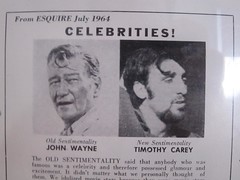I go to New York regularly but I seldom venture out of Manhattan and even more seldom into Queens. I may complain about increasing gentrification of the Lower East Side or the Sexandthecitification of The Bowery but I never run out of things to do there. Well for once I was at a loss for things to do, and maybe the few hours I spent in South Philly gave me a taste and yearning for a big city that was not losing its regional character. Forty-five minutes on the subway, to the eastern terminus of the 7 train, I found that character in Flushing, where the advetrtising was predominantly in Chinese even before I got out of the station.
Whenever I watch Anthony Bourdain's No Reservations, I always salivate over at least some of the regional dishes he tries, and no less so than when he devoted a program to New York. Still, as I tend to do with things I see on tv, I forgot about it. But my friend G., whom I've run into in several different neighborhoods in New York over the years, strongly recommended The Golden Mall in Flushing, not just for the food but for the sensory overload. Thanks, G.
Xi'an Famous Foods, was easy to get to but not that easy to find - I saw at least four different entrances to Golden Mall, and couldn't reproduce how I got there. There is basement entrance to 41-28 Main Street on the corner, and if you can find that, you'll find the liang pi (cold noodles, $5, pictured) and the lamb burger ($2.50, not pictured - it looks like a sloppy joe, but, laced with green chilies and cumin, it tastes much more fantastic), and have an outrageously good and spicy meal with change from a sawbuck.
Whenever I watch Anthony Bourdain's No Reservations, I always salivate over at least some of the regional dishes he tries, and no less so than when he devoted a program to New York. Still, as I tend to do with things I see on tv, I forgot about it. But my friend G., whom I've run into in several different neighborhoods in New York over the years, strongly recommended The Golden Mall in Flushing, not just for the food but for the sensory overload. Thanks, G.
Xi'an Famous Foods, was easy to get to but not that easy to find - I saw at least four different entrances to Golden Mall, and couldn't reproduce how I got there. There is basement entrance to 41-28 Main Street on the corner, and if you can find that, you'll find the liang pi (cold noodles, $5, pictured) and the lamb burger ($2.50, not pictured - it looks like a sloppy joe, but, laced with green chilies and cumin, it tastes much more fantastic), and have an outrageously good and spicy meal with change from a sawbuck.
About a block down and across the street from Golden Mall is the Tai Pan Bakery. Wouldn't animal cupcakes be an intriguing variation on the cupcake craze? The mobile cupcake van could tweet that they're running out of goat. This ram was made of two layers of tiny sponge cake with a creme filling. Not as sastifying to eat as it was to photograph.
See the sidebar on seltzer in part 2. This can of agua con gas is courtesy of the cafe at PS1, the Long Island City affiliate of the Museum of Modern Art, which are both currently exhibiting surveys of performance art - in general at PS1, and, specifically, Marina Abramovic's at Moma. Also recommended at Moma: the work of found poem/collagist/ Manhatan Project scientist Bern Porter, which I found more inspiring and much less crowded (I was the only one there) than the Cartier-Bresson show upstairs. Peppy, a performance artist in his own right who travels with me frequently, is courtesy of my homes. The patriotism is from one of the dollar stores (real cost $2.99) in one of the sensory-overloaded malls along Main Street in Flushing.
Finally, it took me years of visiting New York before I found a chocolate chip cookie to go back for. Within stumbling distance of Eisenberg's is this chewy, vanilla-soaked answer to your cookie questions, from The City Bakery, which is home to an annual hot chocolate festival and the sippable cuppa cocoa you see here.
Finally, it took me years of visiting New York before I found a chocolate chip cookie to go back for. Within stumbling distance of Eisenberg's is this chewy, vanilla-soaked answer to your cookie questions, from The City Bakery, which is home to an annual hot chocolate festival and the sippable cuppa cocoa you see here.















